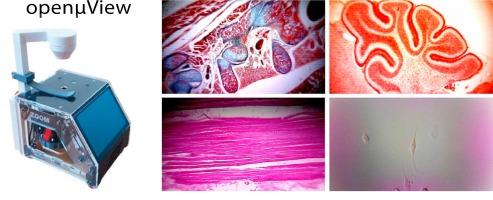Portable, low-cost, desktop microscope
IF 2.1
Q3 ENGINEERING, ELECTRICAL & ELECTRONIC
引用次数: 0
Abstract
Light microscopes became essential tools in everyday lab work a long time ago. However, most commercial microscopes are costly, and they are often bulky and heavy. Therefore, microscopes are rarely seen in mobile applications or used by interested amateurs. Here, we present an affordable, portable single-lens microscope. It essentially uses a Raspberry Pi single-board computer, a camera, a touchscreen display, and an LED ring at its core. Apart from brightfield microscopy, contrast-enhancing methods by oblique, dark-field, and Rheinberg illumination are possible, as well. The microscope is ideal for applications that do not require high-end optical components. Due to its low cost and flexible use, it is also suitable for hands-on experiences of the fascinating world not visible by the human eye.

便携式、低成本台式显微镜
很久以前,光学显微镜就已成为实验室日常工作中必不可少的工具。然而,大多数商用显微镜价格昂贵,而且通常笨重。因此,显微镜很少在移动应用中出现,也很少被感兴趣的业余爱好者使用。在这里,我们介绍一种价格低廉的便携式单镜头显微镜。它主要以 Raspberry Pi 单板计算机、摄像头、触摸显示屏和 LED 环为核心。除明视野显微镜外,还可通过斜照、暗视野和莱茵伯格照明等方法增强对比度。该显微镜非常适合不需要高端光学元件的应用。由于其成本低廉、使用灵活,它还适用于亲身体验人类肉眼无法看到的奇妙世界。
本文章由计算机程序翻译,如有差异,请以英文原文为准。
求助全文
约1分钟内获得全文
求助全文
来源期刊

HardwareX
Engineering-Industrial and Manufacturing Engineering
CiteScore
4.10
自引率
18.20%
发文量
124
审稿时长
24 weeks
期刊介绍:
HardwareX is an open access journal established to promote free and open source designing, building and customizing of scientific infrastructure (hardware). HardwareX aims to recognize researchers for the time and effort in developing scientific infrastructure while providing end-users with sufficient information to replicate and validate the advances presented. HardwareX is open to input from all scientific, technological and medical disciplines. Scientific infrastructure will be interpreted in the broadest sense. Including hardware modifications to existing infrastructure, sensors and tools that perform measurements and other functions outside of the traditional lab setting (such as wearables, air/water quality sensors, and low cost alternatives to existing tools), and the creation of wholly new tools for either standard or novel laboratory tasks. Authors are encouraged to submit hardware developments that address all aspects of science, not only the final measurement, for example, enhancements in sample preparation and handling, user safety, and quality control. The use of distributed digital manufacturing strategies (e.g. 3-D printing) is encouraged. All designs must be submitted under an open hardware license.
 求助内容:
求助内容: 应助结果提醒方式:
应助结果提醒方式:


